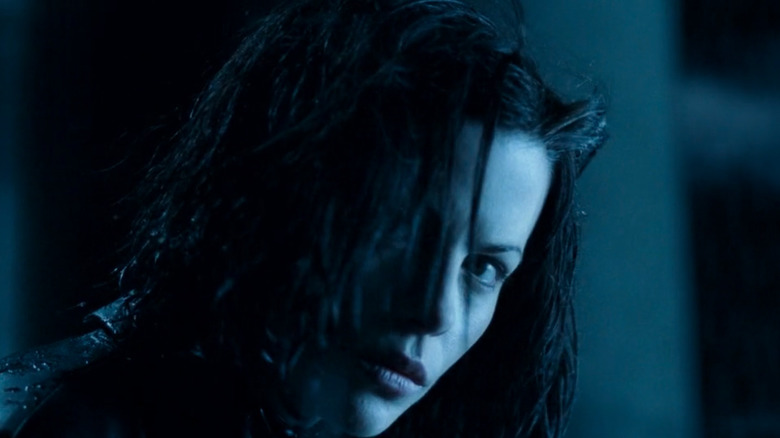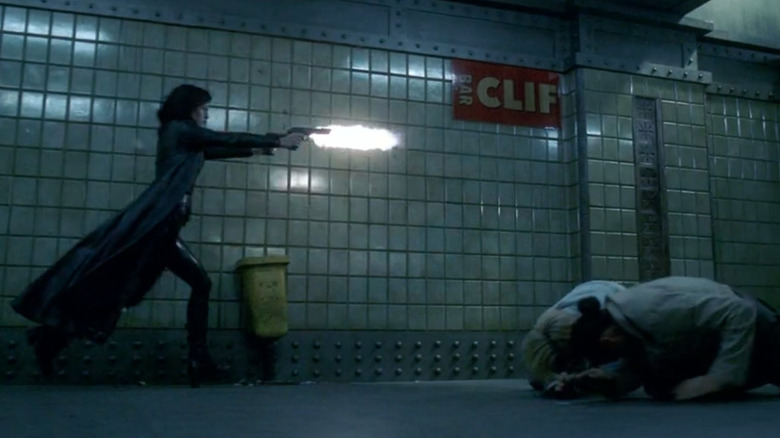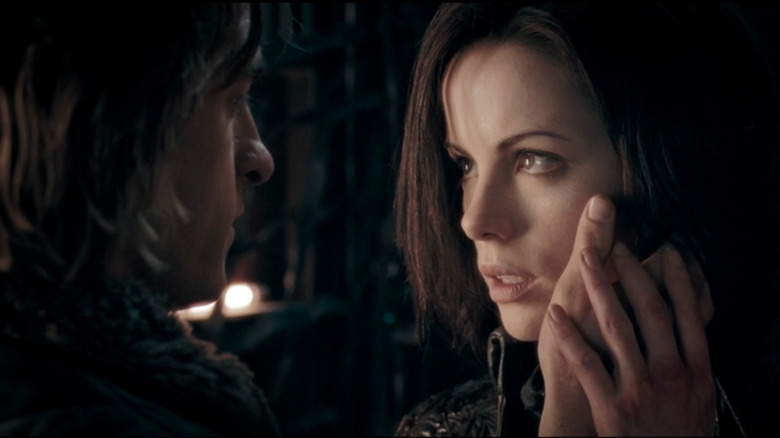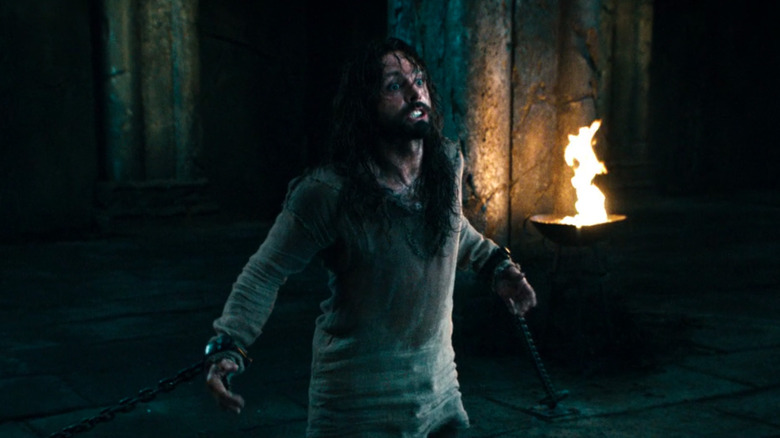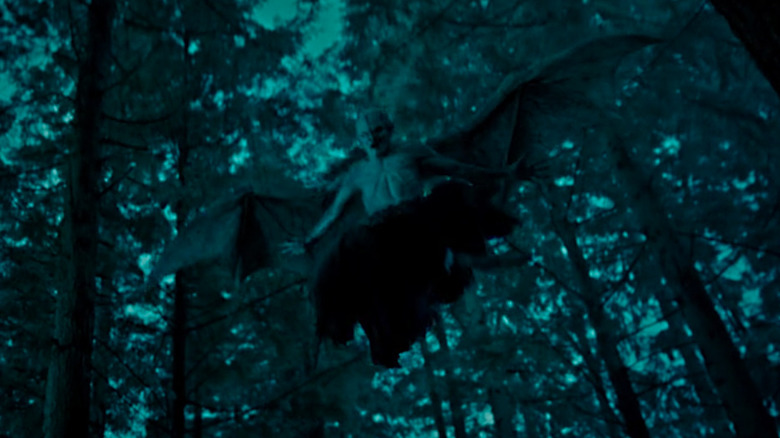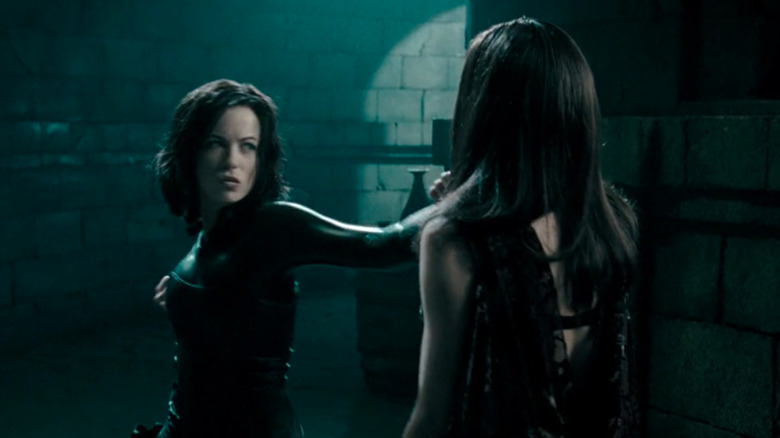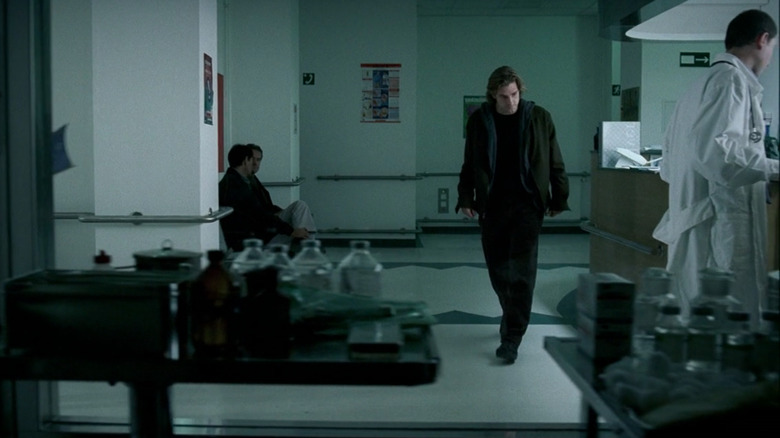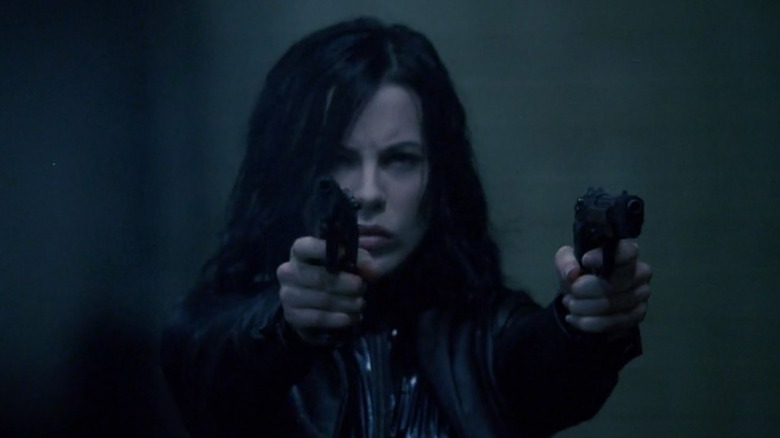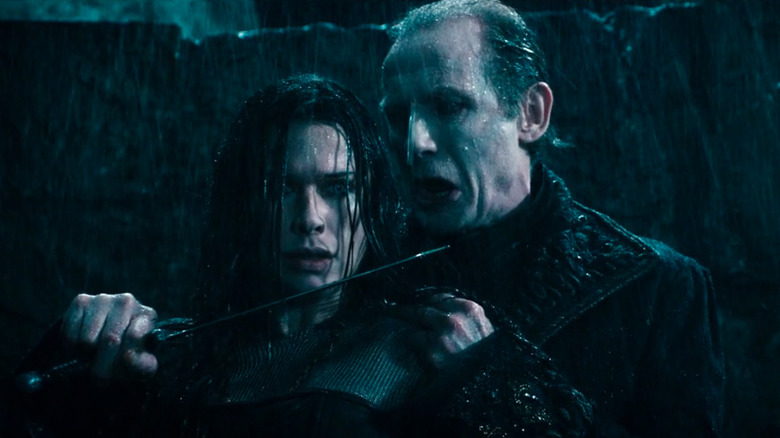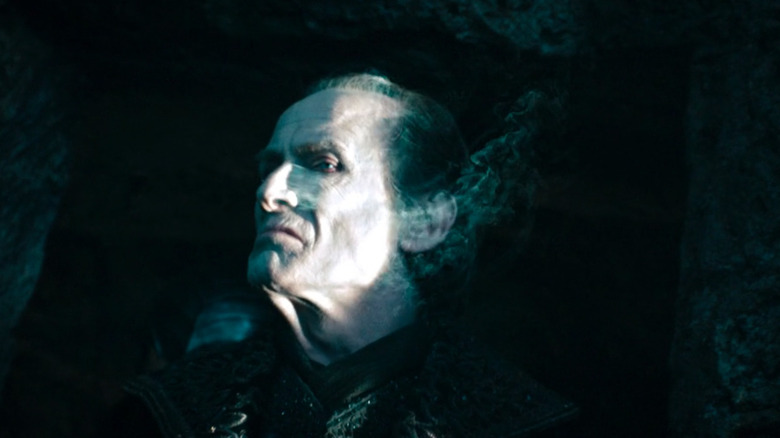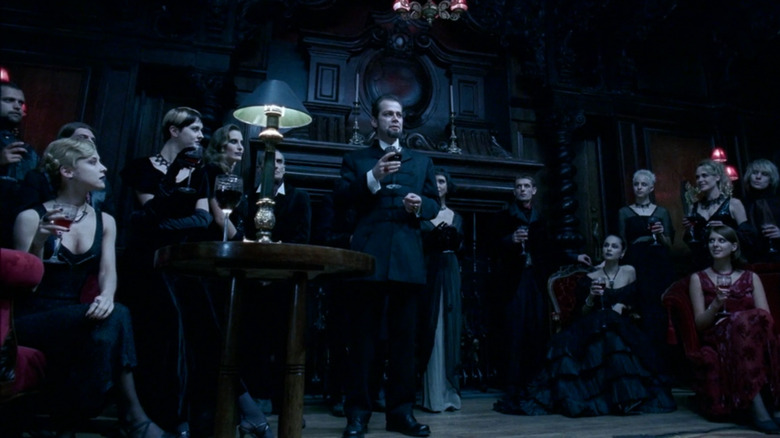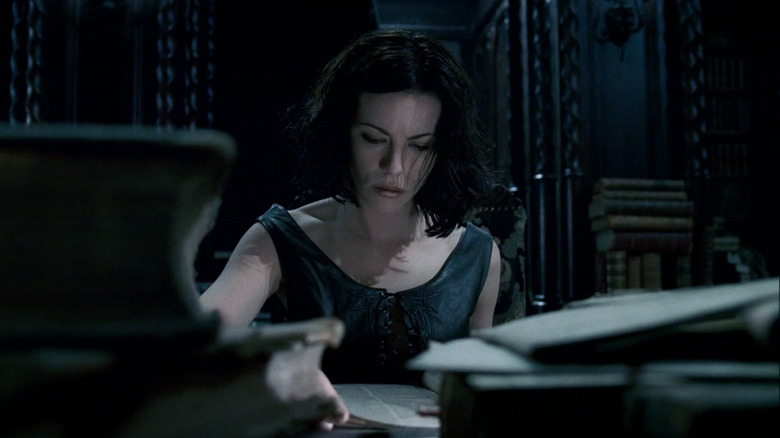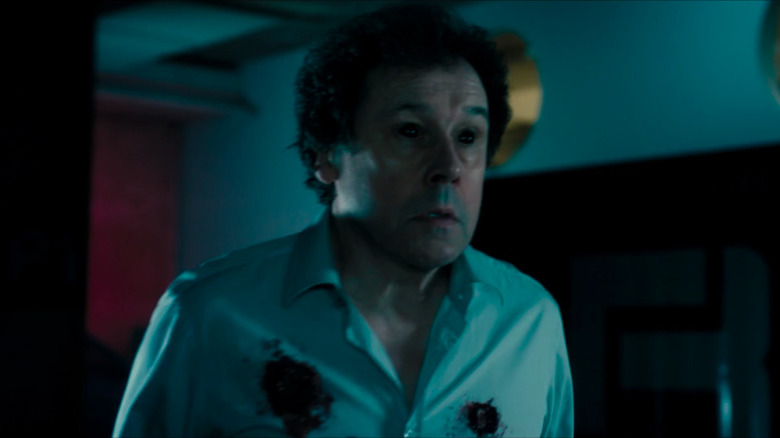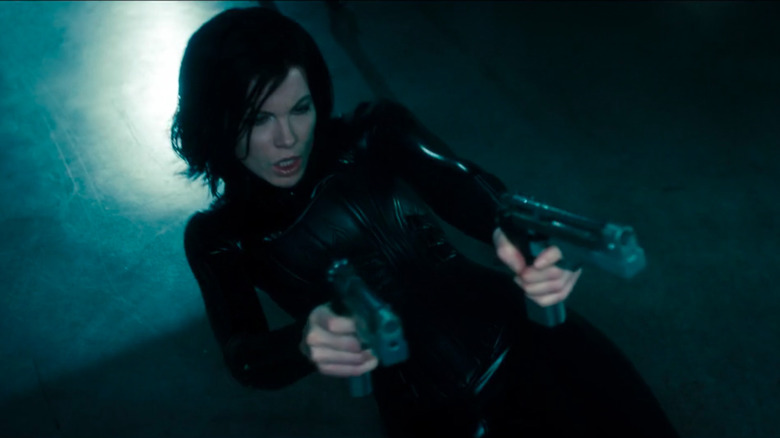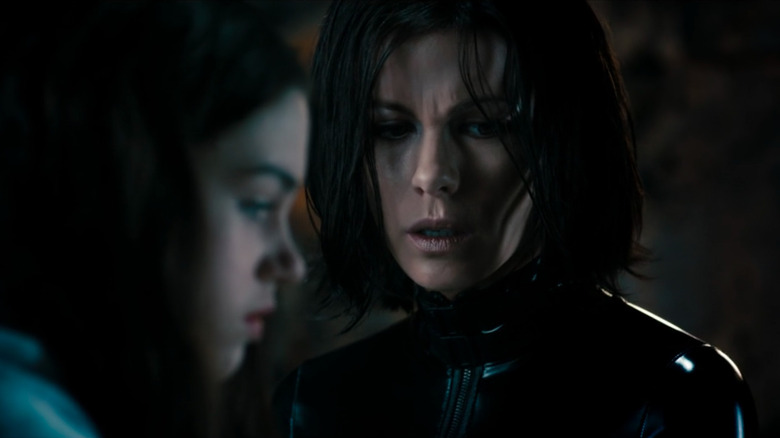Questionable Things We Ignore In The Underworld Franchise
Kate Beckinsale is back in action in "Jolt." But before she kicked ass in the Amazon Prime movie, she proved her action bona fides as vampire Death Dealer Selene in the "Underworld" series.
Across five feature films released between 2003 and 2016, the franchise told the tale of an ongoing war between vampires and the werewolves known as lycans, from its centuries old origins to the present day. For 600 years, Selene was loyal to the vampire elder Viktor (Bill Nighy), until she met Scott Speedman's Michael Corvin, the missing link between the two species who soon became the first vampire-lycan hybrid — as well as the man Selene fell in love with — touching off an adventure that saw Selene dispatch lycans, and the occasional vampire, with coldly efficient abandon.
While the "Underworld" movies were never critical darlings, audiences loved the vampire-versus-lycan action, the supernatural intrigue, and especially Beckinsale's slick, sexy take on Selene. The films would become something of a family affair — Beckinsale married director Len Wiseman shortly after the original film's release (he directed the first two movies and produced the rest), and acted opposite ex-partner Michael Sheen on two of the films. Beckinsale and Wiseman filed for divorce in 2016.
In order to enjoy the series, there were always quite a few things audiences had to overlook — inconsistencies, implausibilities and downright impossibilities that simply couldn't stand up to even the slightest scrutiny. For more than a decade, the series offered great, popcorn-friendly fare — but below is a list of the most questionable things we all have to ignore anytime we watch the "Underworld" films.
Why don't humans know vampires and werewolves exist until the fourth film?
The plot of 2012's "Underworld: Awakening," the fourth film in the series, hinges on humans discovering the existence of vampires and lycans. Yet, the two supernatural species existed — and had been fighting each other — for centuries prior to humanity's realization. While the first film indicates that vampires and lycans have attempted to operate in the shadows, it seems impossible that their conflict has gone unnoticed for so long.
In the second film, "Underworld: Evolution," Alexander Corvinus (Derek Jacobi), the first immortal, indicates he's spent his long life covering up the indiscretions of the two species his twin sons originated, but it's hard to believe he never slipped up over the course of the centuries-long bloodshed between vampires and lycans. Furthermore, even if humans didn't catch on to the presence of the supernatural species earlier, in modern times vampires' and lycans' use of loud guns without silencers would make them especially likely to attract attention. At a minimum, people should have noticed years before the fourth movie since, during the first "Underworld," as the two groups have an intense gun battle in a subway catching multiple humans in the crossfire.
Kate Beckinsale and Scott Speedman have zero chemistry
In the mythology of "Underworld," Kate Beckinsale's Selene and Scott Speedman's Michael are supposed to be supernatural star-crossed lovers. As Michael goes from human to lycan to lycan-vampire hybrid throughout the first film, he and Selene are also supposed to be falling for each other. While the plot of the film makes this clear, Beckinsale and Speedman as actors do not. Theirs is supposed to be an Earth-shattering love, one so powerful that supernatural armies who have battled each other for generations have no choice but to re-evaluate everything and choose sides anew. Instead, their romance is about as sexy as a damp towel.
Even in the second film, as Selene and Michael finally consummate their relationship, the audience gets a scene that shows a lot of skin, yet never bares much of anything. It has all the emotional impact of watching two strangers in parkas, passing in the night.
Ultimately, when it comes to the series' central relationship, the story is better off in the fourth and fifth films, as Selene talks about how much she loves Michael. Having her describe her feelings is much more convincing than actually seeing her with the man she claims to love. Unfortunately, Beckinsale generates more heat with Michael's corpse when she thinks he's dead late in the second movie than she does during the scenes where she's actually interacting with Speedman.
Rise of the Lycans is a short flashback from the first movie expanded to 90 minutes
"Underworld: Rise of the Lycans" is the third movie in the franchise, and the only one that doesn't focus on Selene. The film is a prequel that explains the centuries-old origins of the war between lycans and vampires.
Long ago, werewolves couldn't transform from their canine state until Lucian, the first lycan, was born. The vampires forced Lucian (Michael Sheen) to bite people, making more of his kind, who were then enslaved. That is, until Lucian decided to fight back. However, even after securing his freedom, he wasn't willing to leave without his secret lover Sonja (Rhona Mitra), a vampire who also happened to be the daughter of the vampire leader Viktor. Of course, Lucian and Sonja's relationship was forbidden and when Viktor discovered not only that they were together but that Sonja was carrying Lucian's child, he had Sonja killed.
Yet, even if you haven't seen the third film in the series, this story may sound familiar. That's because Sheen's character relates it in the first film and, if that weren't enough, Michael experiences it in a series of brief flashbacks. So while "Rise of the Lycans" expands on the story by melding the tale of forbidden romance with a slave rebellion, the movie's still a rehash of a storyline that was summed up in just a few minutes in the first "Underworld," making it feel more than a bit redundant.
Why does vampire Marcus have wings?
In the "Underworld" franchise, Alexander Corvinus became the first immortal when his body somehow turned the plague virus to his advantage and granted him eternal life. After he passed this trait on to his twin sons Marcus (Tony Curran) and William (Brian Steele), Marcus was bitten by a bat, becoming the first vampire, and William was bitten by a wolf, becoming the first werewolf. Yet, while William was unable to assume his human form ever again, the movie indicates Marcus became a vampire just like the others presented in the franchise. That is, until we meet him in "Underworld: Evolution" and learn that he has giant bat wings, the apparent result of being awoken from a lengthy sleep by the blood of slain lycan scientist Singe (Erwin Leder).
Marcus spends a majority of the film flying around and using his wings as weapons, but it's unclear why he has them. Early in the story, Selene tells Michael he's the first vampire-lycan hybrid, and therefore there are no limits to what he might be capable of. Yet, later, when Marcus attacks the pair for the first time, Selene realizes he is now a hybrid too. The question is why lycan blood would cause Marcus to sprout wings instead of adopting more lycan-like traits. In the end, it seems Marcus was given his winged advantage because he's the first vampire, but the movie never offers any real explanation.
It's not completely clear what kills vampires
In most vampire properties, the species is particularly vulnerable to wooden stakes through the heart and sunlight. The "Underworld" franchise adheres to only half of that lore, as the only thing that will definitely take out this franchise's vampires is sunlight. In fact, vampires' vulnerability is so extreme that their lycan enemies have learned to make UV bullets so they can destroy vampires even when the sun is down.
Yet, while many vampires die from exposure to UV light throughout the series, there are also many more deaths that aren't dependent on the sun. For example, Viktor dies when Selene lobs off half of his head with a sword. Another elder, Amelia, dies when she is drained of blood.
Although there's a certain logic to these deaths, they're still somewhat surprising. More surprising still are the deaths of two vampires in the series' second entry, who Selene takes out by simply punching them and throwing them against a wall — something even a human could potentially survive, albeit with a nasty concussion. Given the strength and durability this species is supposed to possess, it's hard to believe such a thing would end the life of even the weakest vampire. As a result, it's easy to feel like the series plays a little fast and loose with the rules, largely depending on what works best for the plot.
Most of the movies take place in Eastern Europe, yet everyone is English or American
With the exception of the fourth film, "Underworld: Awakening," the series takes place in an unnamed city in Eastern Europe. From the looks of the language seen on some of the signs, that city is likely in Hungary. Moreover, it seems that characters like Selene, Lucian, and Viktor were born in the area, and yet almost every character speaks with an English or American accent. While some of the actors, including Bill Nighy, attempt something other than their native accent, they're inconsistent and hard to place, making the setting of the films even more difficult to determine.
Most puzzling of all, however, is the fact that when we first meet Michael in "Underworld," he's clearly American, yet he's an intern at a local hospital and the only co-worker he talks to is a fellow intern (Wentworth Miller) who is also American. But if Michael and his co-worker want to be licensed doctors in the United States, they wouldn't do their internships in Eastern Europe. The movie never explains their choice, however. Perhaps the films were supposed to feel like they could take place anywhere, but there's just enough evidence for them being set in a specific real-world location to make the characters' accents extremely confusing.
The vampires' bullet budget must be massive
From the opening scene of the first "Underworld" one thing is abundantly clear: when vampire Death Dealers find their lycan targets, their first response is to unleash a barrage of bullets to take them down. That's also their second, third, and fourth response. So, even though they're trained to use other weapons and engage in hand-to-hand combat, it seems Death Dealers prefer the convenience that comes with a gun and abundant ammunition.
This would be expensive enough if they used regular bullets, but because lycans are vulnerable to silver, they mostly employ specially-made silver bullets, which would be even more costly. This means the vampires' budget for their centuries-long war with the lycans must be massive, even if they've only been able to manufacture their most high-powered rounds starting in the 20th century. Given the expense and the need to keep the war a secret from humans — not to mention, the elite nature of the Death Dealers — it's surprising the vampires on the front lines of the battle weren't trained to conserve bullets by being more strategic about where and when they fire. But instead, their philosophy seems to be shoot first, and as much as possible.
The series has an odd take on fathers and children
"Underworld" features multiple immortal fathers and their supernatural children, but there are two prominent examples who present a sharp contrast.
On one hand, there's the original immortal, Alexander Corvinus, whose sons became the first vampire and werewolf. After Alexander reveals he's spent his lengthy existence covering up the havoc his children have wreaked across the centuries, he's asked why he didn't just kill his sons. But he acts like it would be impossible for him or any other father to do such a thing. Despite this, Marcus demonstrates he doesn't feel the same loyalty to his father, given a short time later he kills Alexander while remarking on his cold heart.
On the other hand, there's Viktor and his daughter Sonja. While Viktor initially seems to want to secure a high place in vampire society for Sonja, when he learns that she's having an affair with the lycan Lucian and pregnant with a child, he condemns her to death. Yet, Sonja's supposed crime is far less horrific than those of Marcus and William. Nonetheless, for the supernatural fathers in the "Underworld" franchise, a vampire daughter getting knocked up by a lycan is an offense that deserves the death penalty, but rampaging around the world killing people for centuries is not. This is easy to overlook while watching the films, but examining the two storylines side by side demonstrates the warped priorities of the series' immortals.
The movies' stylized look makes it seem like it is always night
Since its very first outing, the "Underworld" franchise has employed a highly stylized, blue-filtered look. This mutes colors so everything seems darker, making the image look almost black and white and giving the films a distinctly gritty vibe. It's a perfect look for a series focused on vampires and werewolves. However, there's one drawback to this choice: it makes it seem like the story takes place entirely at night.
In the first "Underworld" film, this was an advantage, since it just so happens that none of the action was set during the day. However, in subsequent films, vampires' allergy to the sun becomes an important plot point. Yet, in each instance, the films have to strain to ensure the audience understands what's going on, since it's challenging to interpret based on what we're seeing, which is still very dark.
Nowhere is this more obvious than in the third film, "Rise of the Lycans," which goes to great lengths to ensure viewers understand the sun is rising. Not only does it include a shot of the sun coming up over the mountains, it also includes a scene that shows Viktor going into and then recoiling from the sun. Most movies could establish this by simply showing light coming into the room. It's a two-second shot. But instead, because of the visual palette chosen in the first "Underworld" and maintained through the others, it is often impossible for audiences to distinguish between day and night.
Vampire society is strangely antiquated
Although the franchise doesn't lay out the way vampire society works in explicit detail, there are multiple clues that we can glean from the way the creatures conduct themselves. First, the vampires live together in one location as a coven. In "Underworld," it's clear there are at least two covens, although the information presented in later films confirms there are actually more. In addition, each coven has a specific leader, usually an elder or, if the elder is taking a centuries-long time-out, whoever the elder chooses as their proxy. Plus, based on Kraven's (Shane Brolly) desire to couple up with an obviously uninterested Selene in the first movie, it seems a relationship with the right person is a means for solidifying and expanding power within a coven.
Yet, this way of living seems strangely antiquated. Between the authoritarian-like leadership and insistence that everyone live together in order to ensure they can be controlled and ordered around, it seems vampire society hasn't changed in centuries, even as the world has moved on. At one point, Selene comments that vampires don't change, yet when it comes to clothes and fighting, her leather outfit and big guns indicate that in some ways vampires have evolved. So, why hasn't vampires' style of living and leadership changed at least the teensiest bit?
How is it possible Selene never got curious about vampire history in 600 years?
Selene emphasizes that she has spent over six centuries dispatching lycans as a Death Dealer in an effort to avenge her human family, who Viktor claimed were killed by the creatures. Yet, in the original "Underworld," Selene discovers Viktor is actually responsible for her family's demise and has been lying about it ever since he made Selene into a vampire. Apparently, Selene never questioned what Viktor told her, even though it seems highly unlikely that she didn't see anything on the night her family perished that might have led her to be suspicious of Viktor's story.
Between that and the fact that she was the one who banished the vampires' historian (who knew all of Viktor's secrets), it's strange that Selene never attempted to look deeper into the origin of her species and herself. Instead, it's not until she notices the lycans following a still-human Michael that she becomes genuinely curious about the stories she's been told about the past. Once she starts seeing holes in the vampires' version of history, she quickly uncovers the truth. However, that raises the question of why nothing else tipped Selene off to Viktor's and Kraven's deceptions at an earlier point in her long, long life.
The plot is mostly driven by lies, deceptions, and omissions of truth
Viktor's lie about who truly murdered Selene's family is only one of many deceptions and omissions of truth that drive the plots of the "Underworld" films. In fact, there are so many characters keeping secrets, often for centuries, that it becomes easy to forget just how much the series hinges on various falsehoods. A small sample of these deceptions includes: Kraven's claim he killed Lucian and his and Lucian's subsequent alliance; Dr. Jacob Lane (Stephen Rea) covering up his status as a lycan while continuing his scientific work to strengthen his race; Thomas (Charles Dance) never telling his son David (Theo James) that his mother is the vampire elder Amelia (Sveta Driga); and Semira's (Lara Pulver) gambit to bring Selene to her coven under false pretenses so she can subdue her and extract the power from her blood that enables her to walk in the sun.
So while supernatural creatures certainly have a lot to hide from the human population, in "Underworld" the vampires and lycans find plenty of reasons to hide things from one another as well, often for selfish reasons that typically come back to haunt them. Yet, through it all, it's Selene who never seems to lie about anything, including her love for Michael.
Selene's leather catsuit looks cool, but is completely impractical
The leather catsuit Kate Beckinsale wears in the "Underworld" films has become iconic. The irony is that Selene's chosen fighting uniform is completely impractical for any kind of actual fighting. While the leather will certainly prevent her from getting hurt too badly if she takes a tumble, that doesn't seem like it would be a huge concern. After all, her vampire healing should be enough to ward off any issues if she falls. On the other hand, if she needs to run, engage in hand-to-hand combat, or move in any other way, the leather in her suit will only constrict her movements, overheat her, and make so much noise that it would be very easy to hear her sneaking up behind you.
Of course, Selene is a vampire, so it's possible she doesn't feel extreme temperatures and she's strong enough to overcome any limitations of the catsuit's leather. But Selene is also a professional Death Dealer, so it seems likely she would want to choose clothes that would best support her work. Still, if movies and TV have taught us one thing, it's that vampires prioritize style over everything else, so perhaps it makes sense that Selene is doing the same.
The rules around vampire pregnancy are a mystery
In most vampire stories, female vampires aren't capable of getting pregnant. Since they can simply bite someone and turn them into one of their kind, they no longer need to reproduce like humans. Yet, in the "Underworld" franchise, there are at least three separate occasions where a female vampire becomes pregnant.
First, after having an affair with Lucian, Sonja becomes pregnant, even though she never gives birth because her father sentences her to die after he learns about the vampire-lycan baby. Then in the fourth film, Selene is awoken after being held for 12 years in a government facility by the daughter she didn't know she was pregnant with when she was captured. Eve (India Eisley) is a hybrid like her father Michael, but she and Selene still share a bond: they can see through one another's eyes. Finally, in the fifth film, it's revealed that David's mother isn't the mystery his father led him to believe, but was actually the vampire elder Amelia, making him, a vampire since birth, the rightful heir to her leadership position within vampire society.
When Sonja revealed her pregnancy, she claimed it was a "miracle," but it's unclear if this was because vampires typically can't get pregnant or for some other reason. One way or another, given how often it comes up in the franchise, it seems vampire pregnancy is rare but possible. Although, like so many other things in these movies, the filmmakers seem to be loathe to provide additional information, preferring instead to keep fans much like they keep their characters — in the dark.
